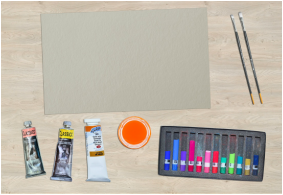 Overcoming artist's block Overcoming artist's block By Rick Jones You just finished setting up an interesting still-life. You placed a couple of apples, a vase of flowers, and some grapes on a lovely piece of fabric, carefully making some folds here and there. You've arranged your still-life in front of a very dark background. Since you positioned a light source coming in from one direction, there's an interesting pattern of darks and lights. Your palette is loaded with colors and all of your supplies are at hand. You've chosen just the right size canvas for your painting and it's properly prepared and placed on your easel. Now, you sit down to paint---and you draw a blank. You're faced with this vast, white canvas staring back at you. You reciprocate with a blank stare back at the canvas. Now what? At one time or another every artist faces this artistic version of "writer's block". Almost every beginner faces it out the gate. The wiring in our brain that has evolved from prehistoric times that protected us from predators and each other triggers our "fight or flight" response when we face fear. And fear is the root cause of artistic or creative mental block. Many questions race through your mind when you first sit down in front of that blank canvas and are confronted with that vast, white nothingness. A beginner may think "What if I mess this up?" "What if I make a mistake?" or "What if people don't like it?" An experienced painter---and this does occasionally happen to them---might wonder "Will this painting be better or worse than my last one?" or "What if the selection committee rejects it?" or "Will this one sell?" Sudden fear can set in whether it's related to failure or success. There are some strategies that may help you overcome this fear, whatever the cause. Step away from your canvas, grab an 18"x24" newsprint pad and some soft pencils (4B or 6B) or soft charcoal and begin sketching your subject in very loose, gestural strokes. Cast aside any thought of careful drawing of shapes and detail. This is an exercise to loosen you up and force you to not only see the subject's overall shape, but the relationships of the shapes within and the shapes between (negative shapes). Spend no more than 1-2 minutes on a series of theses quick studies. You're not trying to capture a "picture" of what you see, but rather the essence of what you see. Keep your strokes fluid and moving freely around the page. After a few of these quick studies, begin to think positive thoughts about what can happen as you begin your painting like "Creating is a lot of fun!" or "I love making art, making something out of nothing!" Once you feel fully engaged in the process, sit back down in front of your canvas, and using a number 4 or 6 round brush, mix up a lighter blue, green, or gray color, and begin loosely sketching in your still-life laying it out on your canvas in an interesting way. There are no rules stating that it has to look exactly like what you see. This approach should get you to focus more on the process of seeing and composing. You'll have time later to think about the finished product as you paint in areas and arrange your colors so they make sense to you. In the meantime, you may notice that your fear has turned into joy! Renaissance Fine Art Supplies in Hamilton, Ohio is a better quality art supply store. Rick Jones owns the store with his wife, Chris, and son, Brandt. They are located in downtown Hamilton at 218 High Street in the Artspace Hamilton Lofts building at the intersection of High and Second. We offer paints, mediums, brushes, canvas, papers, pads, pencils, charcoal, colored pencils, markers, inks, dyes, pens, easels, and much more---including varnishes. Visit: http://www.rfasupplies.com for more information. Article Source: http://EzineArticles.com/?Blank-Canvas-Blues:-How-Do-You-Begin-a-Painting?&id=9364923 Blank Canvas Blues: How Do You Begin a Painting?
0 Comments
|
 RSS Feed
RSS Feed
